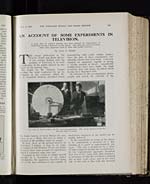John Logie Baird (1888-1946)
Account of some experiments in television
MAY 7, 1924
THE WIRELESS WORLD AND RADIO REVIEW
153
AN ACCOUNT OF SOME EXPERIMENTS IN
TELEVISION.
A good deal of popular interest has been aroused by experiments in
Television recently conducted by Mr. Baird. The following article describes
some early apparatus used by him, and results obtained.
By JOHN L. BAIRD.
THE recent publication in The
Wireless World and Radio Review
of two articles dealing with the
problem of’ Television is in itself
an indication of the public interest in this
subject at the present time.
The article by Mr. Nicholas Langer
describes the work conducted by an in-
vestigator on the continent, whilst Mr.
A. A. Campbell Swinton described before
the Radio Society of Great Britain his own
views as to a likely direction in which a
solution of the problem might be sought.
[NLS note: a graphic appears here – see image of page]
Mr. John L. Baird (right) with the receiving apparatus. The image appears on the disc
when the latter is rotated.
In view, then, of the general interest in
Television, I believe it may be of value
to readers of The Wireless World and Radio
Review to have some account of experiments
which I conducted some time ago.
I propose in this article to confine myself
entirely to a description of my earlier
experiments, the apparatus described being
one of the first constructed and capable of
transmitting only crude outline images.
Since the date of these experiments con-
siderable advance has been made. I am now
engaged on apparatus capable of giving
a certain amount of detail; considerable
modifications have been made, the large
revolving discs and lamps described below
having been dispensed with.
By reference to the accompanying photo-
graphs and sketch the principle of the
mechanism employed in the model can be
readily followed.
In the transmitter an image of the object-
to be transmitted is focussed on a disc
rotating at a speed of approximately 200
r.p.m. This disc is perforated by a series
of holes staggered around the circumference.
In the experimental apparatus described
four sets of five holes were thus arranged;
in proximity to this disc revolved a serrated
disc at some 2,000 r.p.m., and on the other
side of this and in line with the focussed


